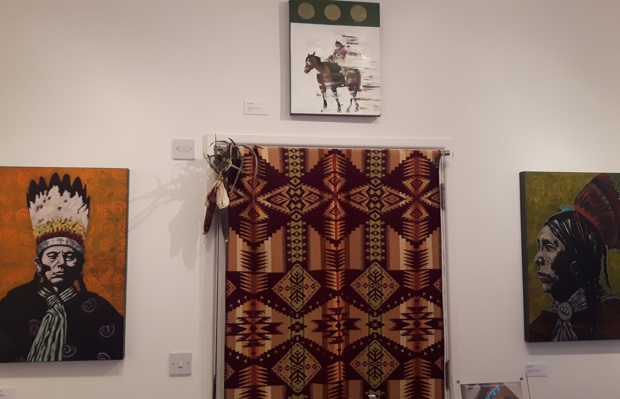(An article I wrote for culturecalling.com)
Discover: Rainmaker Gallery
Rainmaker Gallery sells jewellery and art imported from contemporary Native American artists. Through talks and exhibitions, the gallery attempts to educate and encourage cultural awareness. From paintings to photographs, from Heishe beads to Pendelton Blankets, a wide range of pieces are on offer.
Founded by Joanne Prince twenty-five years ago, Rainmaker Gallery aims to challenge our preconceptions of Native American cultures. There are hundreds of distinct, unique cultures that are encompassed under the label “Native American” – a label that often falls victim to the same reductive stereotype. Prince started as an educator and was shocked at how often people misunderstood this distinction. She found it hard to breakdown these preconceptions, which had often been entrenched from childhood. Through art, however, Prince displays a fascinating alternative to the image of a basic, primitive people we are too often supplied.
As small as it is, Rainmaker provides a doorway from the bustling highstreets of North Bristol into another world. This is a place where rocks are transformed into animals that represent creation and life. This is a place where handmade dolls are infused with character and represent hundreds of unique deities. This is place where coral and shells become cherished jewels instilled with meaning.
Despite these connections to ‘other worldliness’, however, Rainmaker is careful to remind the viewer that these people are contemporary artists, dealing with very real and very present issues. A recent exhibition, Still, displayed the work of Cara Romero, whose hugely powerful photographs show figures suspended in water. Prince has described her as ‘one of the most important Native artists today.’ Originating from the Chemehuevi Valley in the Mojave desert, Romero conveys the fragile and fundamental relationship her tribe have with their valuable water sources. In provocative pieces such as ‘Oil Boom’, she explores this and also hints at the industries that threaten these water supplies.
Other works are perhaps less challenging, but just as compelling. Nocona Burgess—a member of the Comanche Nation of Oklahoma and descendent of one of the most respected leaders, Chief Quanah Parker—seamlessly creates portraits that explore his cultural heritage and yet reference Pop Art. Other artists combine traditional mediums with art inspired by graffiti. These graphic works remind us how current Native American cultures are. Next year, a new exhibition will present Native American women in art, as an alternative to the out-dated, stereotypical views all too frequently advanced in main-stream media depictions, such as in Disney’s Pocahontas.
For lovers of culture, it is so powerful to be able to re-evaluate misconceptions through the medium of art. Bristolians are lucky to have this small outlet of such wide-ranging artworks. It is both important and a pleasure to experience the rich heritage of Native Americans and the beautiful, thought-provoking, political, complex art they continue to produce today.
Find out more about Rainmaker Gallery through their website.
0
Discover: Rainmaker Gallery
23 December 2016 |
We take a look at one of Bristol’s unique attractions, Rainmaker Gallery – a gallery dedicated to the promotion of Native American art and culture.
 |
| Inside the gallery |
Founded by Joanne Prince twenty-five years ago, Rainmaker Gallery aims to challenge our preconceptions of Native American cultures. There are hundreds of distinct, unique cultures that are encompassed under the label “Native American” – a label that often falls victim to the same reductive stereotype. Prince started as an educator and was shocked at how often people misunderstood this distinction. She found it hard to breakdown these preconceptions, which had often been entrenched from childhood. Through art, however, Prince displays a fascinating alternative to the image of a basic, primitive people we are too often supplied.
As small as it is, Rainmaker provides a doorway from the bustling highstreets of North Bristol into another world. This is a place where rocks are transformed into animals that represent creation and life. This is a place where handmade dolls are infused with character and represent hundreds of unique deities. This is place where coral and shells become cherished jewels instilled with meaning.
 |
| Standing Bear- Fetish carving |
Despite these connections to ‘other worldliness’, however, Rainmaker is careful to remind the viewer that these people are contemporary artists, dealing with very real and very present issues. A recent exhibition, Still, displayed the work of Cara Romero, whose hugely powerful photographs show figures suspended in water. Prince has described her as ‘one of the most important Native artists today.’ Originating from the Chemehuevi Valley in the Mojave desert, Romero conveys the fragile and fundamental relationship her tribe have with their valuable water sources. In provocative pieces such as ‘Oil Boom’, she explores this and also hints at the industries that threaten these water supplies.
 |
| Cara Romero's Oil Boom |
 |
| Heishi bead bracelet |
For lovers of culture, it is so powerful to be able to re-evaluate misconceptions through the medium of art. Bristolians are lucky to have this small outlet of such wide-ranging artworks. It is both important and a pleasure to experience the rich heritage of Native Americans and the beautiful, thought-provoking, political, complex art they continue to produce today.
Find out more about Rainmaker Gallery through their website.


















